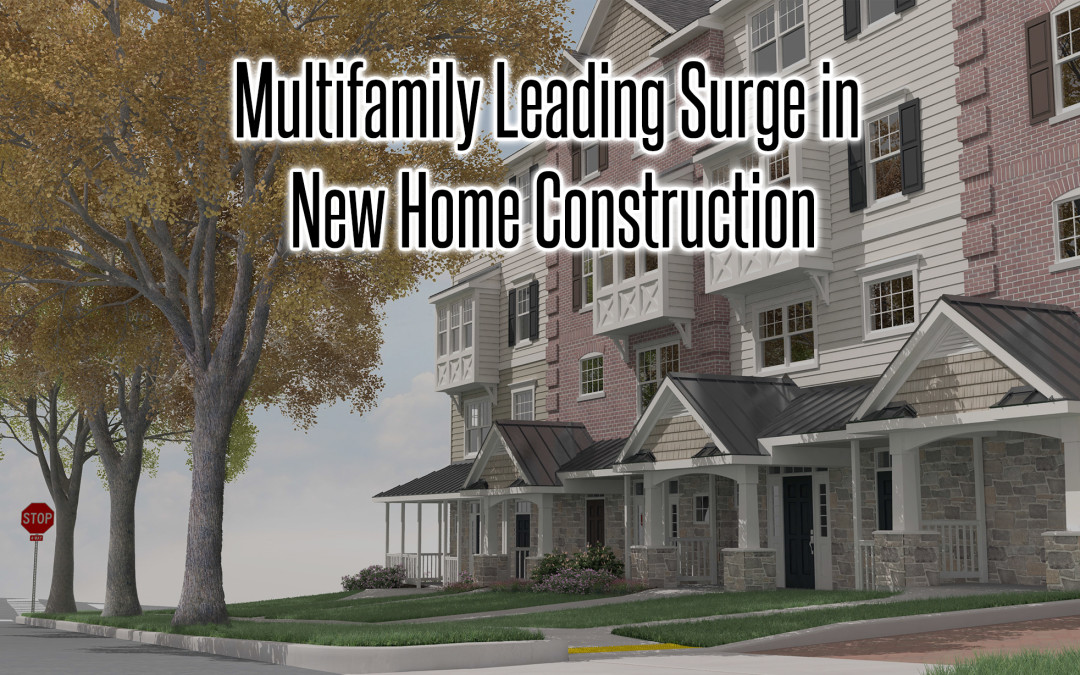
by rtdosen | Dec 8, 2015 | Ryan Dosen Real Estate Articles
Multifamily Leading Surge in New Home Construction By Ryan Dosen New home sales are spiking and builders are investing more and more money to supply an increasing demand for housing. This trend continues not only nationally, but also locally. Local builders, forced to scale back operations after the real estate collapse of the late 2000s, are seeing market conditions improving and inventories remaining low. They are now buying up land, ramping up operations, and looking forward to a very promising near term for new home construction. New Home Sales Rise 10.7 Percent The National Association of Home Builders (NAHB) recently reported that the sales of newly built, single-family homes jumped 10.7 percent in October to a seasonally adjusted annual rate of 495,000 units. Builders seem to have seen this coming and they continue to buy more land and build more homes. Tom Woods, chairman of the NAHB and a home builder from Blue Springs, MO, says that “our builders are reporting continued optimism in the housing market, and are adding inventory in anticipation of future business.” And for new homes, year-over-year growth is even more impressive. David Crowe, NAHB’s Chief Economist, revealed that “sales this year are running 15.7 percent ahead of 2014.” Crowe also says that “with a firming job market, affordable home prices, and rising pent-up demand, today’s report is another indicator that the housing market continues to move on a modest upward trajectory.” Multifamily Construction Leading the Surge The NAHB also reports that total private residential construction spending for October increased to a seasonally adjusted annual rate of $399 billion. A month-over-month breakdown of...

by rtdosen | Dec 8, 2015 | Ryan Dosen Real Estate Articles
Average Home Seller Sees Much to be Thankful For By Ryan Dosen Meet Joe. Joe is your average home buyer. Joe looks a little different today than he did in recent years, but not a lot has changed. Joe is a little less likely to be first time homebuyer and he may even be looking to buy a multi-generational home to take care of parents or grown children. Joe has to deal with lower inventories in his home search, making him spend more money for a home and more time looking for a home. He is also dealing with tight lending requirements that will make buying even more difficult in the unlikely event that he is a first-timer. We just learned a lot about Joe because the National Association of Realtors (“NAR”) recently released its 2015 Profile of Home Buyers and Sellers. There’s nothing too alarming about NAR’s findings, but it is interesting and potentially helpful to take a closer look at the anatomy of today’s home buyer. Today’s Home Buyer NAR reports that average home buyer Joe is 44 years old and most likely married (67 percent chance). He has a median household income of $86,100 and he is buying a home for around $220,000. Joe’s new home was built about 14 years ago, with approximately 1,900 square feet of livable space, three bedrooms, and two bathrooms. Joe’s new home is also just a median distance of 14 miles from his last residence. Joe spent about 10 weeks searching for homes and wound up actually seeing about 10 homes before making a buying decision. He most likely began...

by rtdosen | Dec 8, 2015 | Ryan Dosen Real Estate Articles
Anatomy of a Home Buyer By Ryan Dosen Meet Joe. Joe is your average home buyer. Joe looks a little different today than he did in recent years, but not a lot has changed. Joe is a little less likely to be first time homebuyer and he may even be looking to buy a multi-generational home to take care of parents or grown children. Joe has to deal with lower inventories in his home search, making him spend more money for a home and more time looking for a home. He is also dealing with tight lending requirements that will make buying even more difficult in the unlikely event that he is a first-timer. We just learned a lot about Joe because the National Association of Realtors (“NAR”) recently released its 2015 Profile of Home Buyers and Sellers. There’s nothing too alarming about NAR’s findings, but it is interesting and potentially helpful to take a closer look at the anatomy of today’s home buyer. Today’s Home Buyer NAR reports that average home buyer Joe is 44 years old and most likely married (67 percent chance). He has a median household income of $86,100 and he is buying a home for around $220,000. Joe’s new home was built about 14 years ago, with approximately 1,900 square feet of livable space, three bedrooms, and two bathrooms. Joe’s new home is also just a median distance of 14 miles from his last residence. Joe spent about 10 weeks searching for homes and wound up actually seeing about 10 homes before making a buying decision. He most likely began his search for a...

by rtdosen | Nov 6, 2015 | Uncategorized
Condo Financing Hurdles Abound By Ryan Dosen Buying a condominium unit is probably not as simple as you think. Of course, in the post-recession wake of the real estate and mortgage meltdown of the 2000s, qualifying for a mortgage to buy anything can be quite a challenge. However, most people probably do not know that there are additional hurdles and potential roadblocks to financing and purchasing a condo. We do not have many condominiums in the West Chester, PA area, but there are plenty if you venture out to nearby Philadelphia, Wilmington, or other surrounding areas. Some local townhome projects are actually considered condominiums, and the future may see increased usage of condominiums to help cope with the conflicting needs to preserve our green space and to provide residences for an increasing population. Condo Financing Complications Local mortgage expert Ken Feinman of Approved Mortgage in Doylestown, PA says that buying a condo nowadays can be very challenging if the condo is not already approved by Fannie Mae and Freddie Mac. Fannie Mae and Freddie Mac are government-sponsored entities (“GSEs”) that that buy mortgages from lenders and sell them to investors. The catch is that in order to be purchased, the mortgages have to meet the GSEs’ requirements and be deemed “conforming”. And for condominiums, there are extra requirements for loans to be deemed “conforming”. Feinman says that some of the additional requirements for condos include production of a 90-day homeowners’ association (HOA) budget statement, a master insurance policy for the project, fidelity bond coverage (insuring the association against losses incurred as a result of fraudulent acts), proof of an...

by rtdosen | Nov 6, 2015 | Ryan Dosen Real Estate Articles
Inviting Home Design Trending in 2015 By Ryan Dosen Sophisticated elegance is out. Warm and inviting is in. According to consumer insight obtained by way of Realtor.com’s “Get This Look” promotion, home design is trending away from “look, but don’t touch elegance,” and trending toward “gather-worthy” and more authentic layouts and décor. Many will be preparing soon for holiday gatherings and spring listings, so let’s take a closer look at some of today’s top home design trends. Natural Looking Spaces for Entertaining Realtor.com’s “Get This Look” promotion invited site visitors to vote for their favorite home styles and get a chance to win a $45,000 home makeover by television host and lifestyle expert Jennifer Farrell. Over 100,000 entries were submitted, revealing “Inviting,” “Rustic,” and “Beachside Charm” as the top three home design choices for 2015. Farrell says that “we are seeing a shift in home design trends—leaving behind the glitz and glam for a more natural look—whether that may be a rugged barn with many textures or a serene beach-like feel.” She tells us that “today’s style reflects today’s lifestyle and we’ve found that having a space for entertaining family and friends all year round is the number one trend.” Inviting America’s number one design choice for 2015, receiving 23 percent of the overall vote, is the “Inviting” living space. Realtor.com describes an Inviting living space as “a welcoming atmosphere that includes fun barware, plenty of seating and a gather-worthy kitchen that can serve as the life of the party.” If you’re thinking about updating your home, consider staying with the trend of opening up your kitchen and floor...







Recent Comments